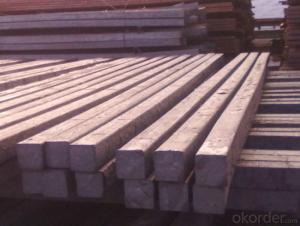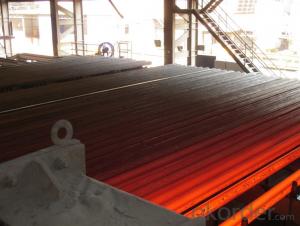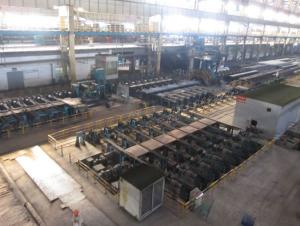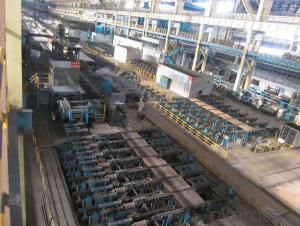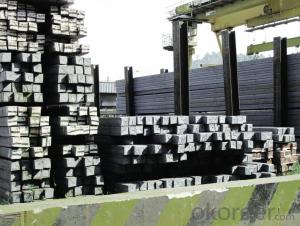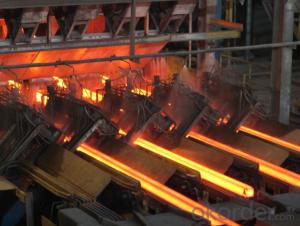Hot Rolled Square Steel Billet 3SP 80mm
- Loading Port:
- Shanghai
- Payment Terms:
- TT OR LC
- Min Order Qty:
- 2000 m.t.
- Supply Capability:
- 10000 m.t./month
OKorder Service Pledge
OKorder Financial Service
You Might Also Like
Structure of Hot Rolled Square Steel Billet 3SP 80mm

Description of Hot Rolled Square Steel Billet 3SP 80mm
PPGI is made by cold rolled steel sheet and galvanized steel sheets as baseplate, through the surface pretreatment (degreasing, cleaning, chemical conversion processing), coated by the method of continuous coatings (roller coating method),
and after roasting and cooling. Zinc coating: Z60, Z80, Z100, Z120, Z180, Z275, G30, G60, G90
Alu-zinc coating: AZ60, AZ80, AZ100, AZ120, AZ180, G30, G60, G90
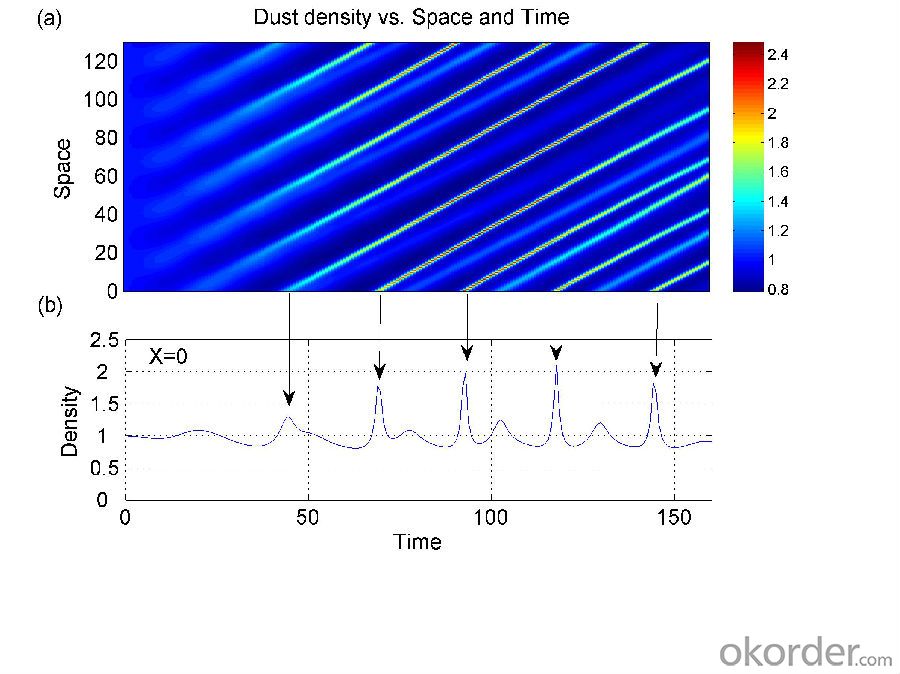
Main Feature of Hot Rolled Square Steel Billet 3SP 80mm
1) Excellent corrosion resistance: The zinc layer provides a good protection of Pre-painted Galvanizeed Steel Sheet.
2) High heat resistance: The reflective surface of the material aids in efficiently reflecting the sunlight away and in turn reducing the amount of heat transmitted. The thermal reflectivity converts into energy savings.
3) Aesthetics: Pre-Painted Galvanized steel sheet is available in plethora of patterns and multiple sizes as per the requirements that given by our customers.
4) Versatility: can be used in the various areas.Standard seaworthy export packing: 3 layers of packing, inside is kraft paper, water plastic film is in the middle and outside GI steel sheet to be covered by steel strips with lock, with inner coil sleeve.
Applications of Hot Rolled Square Steel Billet 3SP 80mm
1) Automotive bodies: filters, fuel tanks, etc.
2) Construction materials: roofings, welding pipes,
3) Electric and electronic appliances: computer cans, etc.
4) Steel cans: containers, etc.
5) Steel furniture: washing machines, refrigerators, microwaves, etc.
6) Drums
7) Office equipment: printer, recorders, etc.
8) Motors and transformers

Specifications of Hot Rolled Square Steel Billet 3SP 80mm
| Classified symbol | Yield Point Minimum N/mm2 | Tensile Strength Minimum | Elongation Minimum % | Application | ||||
| N/mm2 | Nominal Thickness mm (t) | |||||||
| JIS | Yogic | 0.25-0.4 | 0.4-0.6 | 0.6-1.0 | 1.0-1.6 | |||
| G3312 | specification | |||||||
| CGCC | CGCC | -205 | -270 | -20 | -21 | -24 | -24 | Commercial |
| CGCD | CGCD | --- | 270 | --- | 27 | 31 | 32 | Drawing |
| --- | CG340 | 245 | 340 | 20 | 20 | 20 | 20 | Structural |
| CGC400 | CG400 | 295 | 400 | 16 | 17 | 18 | 18 | Structural |
| CGC440 | CG440 | 335 | 440 | 14 | 15 | 16 | 18 | Structural |
| CGC490 | CG490 | 365 | 490 | 12 | 13 | 14 | 16 | Structural |
| CGC570 | CG570 | 560 | 570 | --- | --- | --- | --- | Structural |
| ASTM Designation | Yield Point Minimum | Tensile Strength Minimum | Elongation Minimum % | Application | Q/BQB 445-2004(China standard) | ASM A653/A653M | JISG 3312 | |
| ksi(MPa) | ksi(MPa) | TDC51D+Z | (CS TYPE A+Z) | CGCC | ||||
| A653(M)-99 CS TYPE A,B,C | --- | --- | --- | Commercial | TDC52D+Z | CGCD | ||
| A653(M)-99 FS | --- | --- | --- | Lock Forming | TS250GD+Z | (G250+Z) | - | |
| A653(M)-99 DS | --- | --- | --- | Drawing | TS300GS+Z | (G300+Z) | CGC 400 | |
| A653(M)-99 SS Grade33(230) | 33(230) | 45(310) | 20 | Structural | TS350GD+Z | (G350+Z) | CGC490 | |
| A653(M)-99 SS Grade37(255) | 37(255) | 52(360) | 18 | Structural | TS550GD+Z | (G550+Z) | CGC570 | |
| A653(M)-99 SS Grade40(275) | 40(275) | 55(380) | 16 | Structural | ||||
| A653(M)-99 SS Grade50(345) | 50(345) | 65(450) | 12 | Structural | ||||
| A653(M)-99 SS Grade80(550) | 80(550) | 82(570) | --- | Structural | ||||
FAQ of Hot Rolled Square Steel Billet 3SP 80mm
We have organized several common questions for our clients,may help you sincerely:
1. How Can I Visit There?
Our company is located in Tianjin City, China, near Beijing. You can fly to Tianjin Airport Directly. All our clients, from home or aboard, are warmly welcome to visit us!
2. How Can I Get Some Sample?
We are honored to offer you sample.
3. Why choose CNBM?
1, ISO, BV, CE, SGS approved.
2, Competitive price and quality.
3, Efficient service team online for 24 hours.
4, Smooth production ability(50000tons/month) .
5, quick delivery and standard exporting package.
6, Flexible payment with T/T, L/C, Paypal, Kunlun bank, etc .
- Q:What are the main factors affecting the microstructure of steel billets?
- The main factors affecting the microstructure of steel billets include the composition of the steel, the cooling rate during solidification, the presence of impurities or alloying elements, and the heat treatment processes applied.
- Q:How are steel billets used in the manufacturing of hydraulic systems?
- The manufacturing of hydraulic systems relies on steel billets, which serve as the raw material for a variety of components. To withstand the high pressures and forces involved, hydraulic systems require sturdy and long-lasting parts. To shape the steel billets into the desired form, they are first heated and then processed through methods like hot rolling or extrusion. These processed steel billets are then further transformed into different hydraulic system components, including cylinders, pistons, valves, and fittings. The utilization of steel billets offers several advantages in the manufacturing of hydraulic systems. Firstly, steel is well-known for its strength and toughness, making it ideal for enduring the extreme pressures and forces experienced in hydraulic systems. Additionally, steel boasts excellent resistance to corrosion, which is essential given the exposure to fluids and harsh environments in hydraulic systems. Moreover, steel billets can be easily machined and welded, enabling the creation of intricate and customized hydraulic components. The versatility of steel billets allows for the production of various shapes and sizes required for different applications within hydraulic systems. Overall, steel billets play a crucial role in the manufacturing of hydraulic systems by providing a resilient, durable, and adaptable material for the production of essential components. Their use guarantees the dependability and efficiency of hydraulic systems, enabling them to perform their intended functions across numerous industries such as construction, manufacturing, and transportation.
- Q:How are steel billets used in the production of building facades?
- Steel billets are an important component in the production of building facades due to their versatility and strength. Building facades are the external covering or cladding of a building, which not only provides an aesthetic appeal but also serves as a protective barrier against external elements. Steel billets, which are semi-finished steel products, are used in the production of building facades in several ways. Firstly, they are often used as the primary material for the structural framework of the facade. Steel billets are known for their high strength-to-weight ratio, making them an ideal choice for supporting the weight of the facade and providing structural stability to the building. Additionally, steel billets can be further processed to create various shapes and profiles required for the design of the facade. These shapes can be formed through processes such as hot rolling, cold rolling, or extrusion, allowing for intricate and customized designs. This flexibility in shaping steel billets enables architects and designers to create unique and aesthetically pleasing facades that enhance the overall appearance of the building. Steel billets are also used in the production of curtain wall systems, which are commonly utilized in modern building facades. Curtain walls are lightweight, non-structural cladding systems that are attached to the building's structural framework. Steel billets are often utilized in the creation of curtain wall support systems, providing the necessary strength and durability to withstand wind loads, seismic forces, and other external pressures. Moreover, steel billets can be coated or treated with various finishes to enhance their corrosion resistance and improve their longevity. These finishes can range from galvanization to powder coating, ensuring that the building facade remains durable and aesthetically appealing over time. In summary, steel billets play a crucial role in the production of building facades by providing strength, flexibility in design, and durability. Their utilization in the structural framework, creation of customized shapes, support systems for curtain walls, and application of protective finishes make them an indispensable material in the construction industry.
- Q:How are steel billets used in the production of molds?
- Steel billets are used in the production of molds as a raw material. They are melted, shaped, and cooled to form the mold, which is then used to cast various products. The steel billets provide the necessary strength and durability to withstand the high temperatures and pressures involved in the molding process.
- Q:100Q235 steel can only be rolled from billets of Q235?Or a billet can be rolled into Q195~Q215 and other models of steel?Is there a detailed classification of billets? Do you have GB?
- Billet classification of GB, it is convenient to check
- Q:What are the different surface defects in steel billets?
- There are several different types of surface defects that can be found in steel billets. These defects can occur during the manufacturing process or as a result of handling and transportation. Some common surface defects in steel billets include: 1. Scale: Scale is a thin layer of oxide that forms on the surface of steel billets during the heating and rolling process. It appears as a rough, flaky coating and can negatively affect the surface quality and appearance of the billet. 2. Cracks: Cracks can occur on the surface of steel billets due to various reasons such as improper cooling, excessive rolling pressure, or high levels of stress during handling. These cracks can range from minor surface cracks to more severe deep cracks, compromising the integrity and strength of the billet. 3. Lamination: Lamination defects occur when there are layers or sheets of non-metallic inclusions within the steel billet. These layers can cause weak spots in the billet, making it susceptible to failure under stress. 4. Pitting: Pitting is the formation of small, localized cavities or depressions on the surface of the steel billet. It can be caused by various factors such as corrosion, improper cleaning, or exposure to corrosive environments. 5. Slivers: Slivers are thin, elongated pieces of steel that protrude from the surface of the billet. They can be caused by improper cutting or shearing operations, which can result in sharp edges and potential safety hazards. 6. Rolled-in scale: Rolled-in scale refers to the presence of scale that has been embedded into the surface of the billet during the rolling process. This can affect the surface finish and may require additional cleaning or surface treatment. 7. Surface scratches: Surface scratches are shallow marks or abrasions on the surface of the steel billet. They can occur during handling, transportation, or as a result of contact with abrasive surfaces. While they may not significantly impact the structural properties of the billet, they can affect the aesthetics and may require further treatment or polishing. It is important to identify and address these surface defects in steel billets to ensure the quality and performance of the final product. Regular inspection, proper handling, and appropriate surface treatment techniques can help minimize these defects and improve the overall quality of the steel billets.
- Q:What are the different types of surface coating methods used for steel billets?
- There are several different types of surface coating methods that are commonly used for steel billets. These methods are employed to enhance the durability, corrosion resistance, and overall performance of the steel billets. Some of the commonly used surface coating methods for steel billets include: 1. Hot-dip galvanizing: This method involves immersing the steel billets in a bath of molten zinc. The zinc coating forms a protective layer on the surface of the steel, preventing corrosion and providing excellent durability. 2. Electroplating: In this method, a thin layer of metal, such as zinc, nickel, or chromium, is electrochemically deposited onto the surface of the steel billets. This coating provides enhanced corrosion resistance and improves the aesthetic appearance of the steel. 3. Powder coating: Powder coating involves applying a dry powder onto the surface of the steel billets, which is then heated to form a protective layer. This method provides excellent durability, resistance to chemicals, and a wide range of color options. 4. Paint coating: Paint coating involves applying a liquid paint onto the surface of the steel billets. The paint forms a protective layer that provides corrosion resistance and can be customized with different colors and finishes. 5. Thermal spray coating: This method involves spraying molten or powdered metals onto the surface of the steel billets using a thermal spray gun. The coating provides excellent wear resistance, corrosion protection, and can be customized with different materials. 6. Anodizing: Anodizing is commonly used for aluminum billets, but can also be applied to steel. It involves creating an oxide layer on the surface of the steel billets through an electrochemical process. This coating improves corrosion resistance and provides a decorative finish. Each of these surface coating methods has its own advantages and disadvantages, and the choice of method depends on factors such as the desired level of protection, aesthetics, and the specific requirements of the steel billets.
- Q:What are the potential applications of steel billets in the oil and gas sector?
- Due to their excellent mechanical properties and durability, steel billets offer a wide range of potential applications in the oil and gas sector. Here are several examples: 1. Drill pipes and casings: Manufacturing drill pipes and casings, which are vital components in the drilling process, can be achieved using steel billets. These pipes and casings must endure high pressure and extreme temperatures, necessitating the strength and toughness provided by steel billets. 2. Pipelines: Steel billets can be utilized to create seamless or welded steel pipes for oil and gas pipelines. These pipes are responsible for transporting oil, gas, and other petroleum products across long distances. Steel billets ensure the durability and integrity of the pipelines, withstanding high pressure, corrosion, and impact. 3. Offshore structures: Steel billets are also essential in constructing offshore platforms, drilling rigs, and other structures used in extracting and producing oil and gas from offshore reserves. These structures are exposed to harsh marine conditions, including saltwater, wind, and waves. Steel billets provide the necessary strength and corrosion resistance to withstand these challenging environments. 4. Pressure vessels and storage tanks: Steel billets can be employed in manufacturing pressure vessels and storage tanks used for storing and transporting oil, gas, and various chemicals. These vessels and tanks must withstand high pressure and temperature variations without compromising safety. Steel billets offer the required strength and resistance to corrosion and leakage. 5. Equipment components: Steel billets are also used in fabricating various components and equipment used in the oil and gas sector, such as valves, flanges, fittings, and connectors. These components are crucial for the operation and maintenance of oil and gas facilities, and steel billets ensure their reliability and performance. In conclusion, the potential applications of steel billets in the oil and gas sector are extensive and diverse, covering various stages of exploration, production, transportation, and storage. Their exceptional strength, durability, and resistance to extreme conditions make them an ideal material choice for critical applications in this industry.
- Q:What are the different grades of steel billets?
- There are several different grades of steel billets, including low carbon steel, medium carbon steel, high carbon steel, alloy steel, and stainless steel. The specific grade of steel billet used depends on the intended application and desired properties of the final product.
- Q:Can steel billets be used for artistic purposes?
- Yes, steel billets can certainly be used for artistic purposes. While steel billets are typically used as raw material in industrial applications such as construction or manufacturing, they can also be transformed into beautiful works of art. Artists often use steel billets to create sculptures, decorative pieces, or even functional objects like furniture. The versatility of steel allows artists to mold and shape it into various forms, while its strength and durability ensure the longevity of the artwork. Moreover, the metallic appearance of steel can add a modern and industrial aesthetic to artistic creations. Overall, steel billets offer artists a unique medium to express their creativity and create visually stunning pieces.
1. Manufacturer Overview |
|
|---|---|
| Location | |
| Year Established | |
| Annual Output Value | |
| Main Markets | |
| Company Certifications | |
2. Manufacturer Certificates |
|
|---|---|
| a) Certification Name | |
| Range | |
| Reference | |
| Validity Period | |
3. Manufacturer Capability |
|
|---|---|
| a)Trade Capacity | |
| Nearest Port | |
| Export Percentage | |
| No.of Employees in Trade Department | |
| Language Spoken: | |
| b)Factory Information | |
| Factory Size: | |
| No. of Production Lines | |
| Contract Manufacturing | |
| Product Price Range | |
Send your message to us
Hot Rolled Square Steel Billet 3SP 80mm
- Loading Port:
- Shanghai
- Payment Terms:
- TT OR LC
- Min Order Qty:
- 2000 m.t.
- Supply Capability:
- 10000 m.t./month
OKorder Service Pledge
OKorder Financial Service
Similar products
New products
Hot products
Related keywords
